Interviews with experts and opinion leaders from our research network
The Asian economy continues to grow even after going through the currency crisis in the latter half of 1990s. At the same it still face issues like rising income gaps and the “middle-income trap”*. In this interview, we speak with Mr. Takehiko Nakao, President of the Asian Development Bank, about Asia’s future, Japan’s role in Asia, and the role that Japanese companies should play to support Asian development.
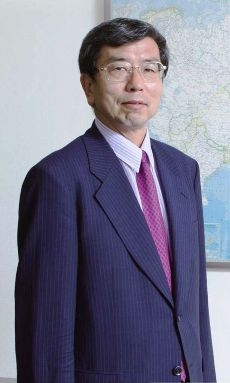
President of the Asian Development Bank (ADB), Former Vice- Minister of Finance for International Affairs at the Ministry of Finance of Japan.
Career Summary.
March 1956 Born in Osaka
March 1978 Graduated from the Faculty of Economics at the University of Tokyo
April 1978 Joined the Ministry of Finance of Japan
June 1982 Completed an MBA from the Haas School of Business at the University of California, Berkeley
Thereafter, Nakao held the posts of Director of the Osaka Regional Taxation Bureau’s Izumiotsu Local Tax Office, as well as Deputy
Director of the Security Bureau, Deputy Director of the Tax Bureau, and Deputy Director of the International Finance Bureau. Later on,
Nakao assumed the position of Advisor in the Policy Development and Review Department of the International Monetary Fund (IMF).
Subsequently, in the Ministry of Finance of Japan, he held the positions of Director of the Banking Bureau’s Non-bank Division, Director of
the International Bureau’s International Organizations Division, Budget Examiner in charge of Foreign Affairs, Economy, Trade and Industry,
and ODA at the Budget Bureau, and Director of the International Bureau’s Development Policy Division. He was assigned as Minister
at the Embassy of Japan in the United States. After returning to Japan, he held the post of Senior Deputy Director-General of the International
Bureau in the Ministry of Finance of Japan.
July 2009 Director-General of the International Bureau
August 2011 Vice-Minister of Finance for International Affairs atthe Ministry of Finance of Japan
April 2013 President of the ADB He is an author of many books including “America’s Economic Policies” (2008: Chuko-shinsho) and academic papers (in English and Japanese).
Kawamura: After joining the Ministry of Finance of Japan, you held many positions in various bureaus such as Tax, Security, Budget and International Finance and you also worked at the International Monetary Fund, as well as becoming Minister of the Embassy of Japan in the United States. To begin, what made you decide to join the Ministry of Finance?
Nakao: I studied macroeconomics, in particular, international finance at university and I thought that working for the Ministry of Finance would give me the opportunity to apply my academic thinking to the entire country. The Ministry of Finance gave me an offer so I decided to join. Later, while working for the government, I felt that what I had studied at university was more useful than I had expected, even though many people may not agree with this opinion. For example, I had examined issues relating to the market such as when the government should step in or the role government should play. In economics, diplomacy, police, roads, and bridges are considered “public goods.” In other words, taxfunded services provided by government that are useful for all of society but for which payment from individuals is difficult.
Even with some items including education which cannot be called public goods in a strict sense, governments in all countries take responsibility to provide or support such items if they have a broad positive “external economic effect” on society, if they are necessary in public policy, or if support is necessary from the viewpoint of fairness. In the Budget Bureau, I was in charge of the Ministry of Economy, Trade and Industry and Ministry of Foreign Affairs, and I always thought about why a certain project had to be supported by the government and why we could not let the market handle it. An example of what sort of role the government and markets should play can be found in the smalland medium-sized companies sector. Is support for small- and medium-sized companies done for the purpose of fairness? If we left it up to the market, would efficiency be damaged due to the asymmetric nature of information and difference in negotiating ability of large companies? To put it another way, are there any aspects in which economic growth is blocked? I always thought about such matters. I think it is very useful to sort out national policies based on economic theories for budget and taxation, as well as for international finance.
Kawamura: In the ADB, the long-term strategic framework “Strategy 2020” was formulated in 2008, and it focuses on the reduction of poverty and improvement in the quality of living conditions. Can you explain to us the roles of the ADB once again?
Nakao: The ADB is an international financial institution established in 1966 by Asian and Pacific countries, as well as countries from the Americas and Europe under the leadership of Japan and the US. Out of 67 member countries, 19, including the US, come from outside Asia. Within Asia we have both developing and advanced economy member countries with the latter including Japan, Australia, and New Zealand. Initially, the ADB focused mainly on loans for infrastructure to support development and growth in the region. From the 1990s the emphasis shifted to put more focus on poverty reduction. Measures to reduce the number of people suffering from extreme poverty (living on an income of US$1.25 a day or less) are a key element of our mission and we have seen the number of people in this poverty bracket falling sharply over the decades. Now, about 700 million people out of 3.5 billion in Asia and the Pacific live on an income of US$1.25 or less a day. We also provide support in areas such as health, education, protection of the vulnerable and capacity building, as part of our wider poverty reduction efforts.
At the same time, of course, assistance for infrastructure development including electricity, roads, railways, and ports, remains important. You may think infrastructure development is merely to support economic development rather than to reduce poverty. However, as we can see from the experiences of Japan and other developed countries in Asia and elsewhere, the rollout of power networks, quality roads and ports, etc., provides a foundation for growth that gradually brings affluence to citizens, and is effective for reducing poverty. In addition, without quality roads and reliable electricity supplies, it is not easy to receive education and visit hospitals, or to seek new opportunities for better livelihood.
This is especially the case for women in remote communities who want to travel into towns to access social services and to seek income earning opportunities. Promoting women’s advancement is another important part of our mission. In our region, many countries are transitioning from lowincome to middle-income status and they must address new challenges including tackling aging populations, improving the quality of education and infrastructure, and creating user-friendly and environmentally sustainable urban centers. Many of these countries can now tap their own funding for infrastructure development but are in need of specialist knowledge and know-how.
Without technological know-how, they might be better off tapping US dollar financing and knowledge support for infrastructure development from the ADB rather than raising finance alone. The kind of services the ADB can provide middle-income countries in the future is one of the main issues we face. After I was appointed President, we examined our development strategy for both existing issues and future challenges and the findings were summarized in our Strategy 2020 Midterm Review released this spring.
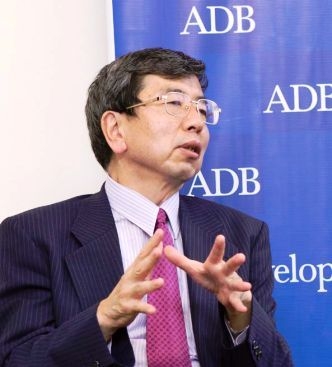
Kawamura: What about technical assistance?
Nakao: Technical assistance has been an important part of the ADB’s operations for low- and middle-income countries since we began, and it covers many sectors and themes such as infrastructure project preparation, education, health, fiscal administration, and environmental protection. Years ago when Japan was constructing expressways, the World Bank provided not only loans to Japan but valuable know-how as well regarding the design of expressway turns. In the same fashion our technical assistance is also included in implementing projects.
Kawamura: How does the ADB finance its operations?
Nakao: Our assistance comes from ordinary capital resources (OCR) and special funds. For OCR, finance is raised by issuing debt securities with the monies loaned at interest rates where the spread, which is a cost, is added. Currently the approved annual limit for OCR lending is about US$10 billion. Our special or concessional lending rate funds provide finance at low interest rates and for the long term. The new approved total for these funds is about US$3 billion. They include contributions from Japan and elsewhere. While these might seem substantial amounts, estimates put the financing needs for infrastructure development, alone, in Asia at about US$800 billion a year. To meet these huge requirements, government funds from each country, as well as domestic and foreign private funds should play a large role. In the case of the ADB we are constantly seeking to mobilize co-financing support for our operations. At the same time the financing role we play in supporting development in Asian will become relatively weaker over time if our resources remain the same as in the past. How we boost our financing ability in the future is one of the issues we face.
Kawamura: Given the need for more funds for infrastructure development, there have been recent reports of a plan by the People’s Republic of China (PRC) to establish an Asia Infrastructure Investment Bank (AIIB)*. What are yourthoughts on this?
Nakao: This is a question that has been asked quite often recently and we are obviously aware of the reports of efforts to establish an international financial institution under the PRC’s leadership. As stated, there is a large demand for infrastructure in Asia and the ADB’s financing levels are not enough to meet these enormous needs. The PRC has a large amount of foreign currency reserves, and are thinking they would like to play a greater role in this area. The PRC authorities have repeatedly stated that AIIB will not be a rival of the ADB but a bank that supplements our function. This is understandable. At the same time, as a member of the ADB, I hope that the PRC will continue to support us. It has to be stated that in the areas of procurement, and environmental and social safeguards, the ADB sets high standards in its projects, and new banks also need to place importance on these matters. The Export-Import Bank of China and the China Development Bank already provide financing on a large scale to developing countries, and they have been asked internationally to set stricter environmental and social safeguard standards for their investment projects.
Kawamura: If these two international financial institutions eventually stand side by side, what advantages can the ADB emphasize?
Nakao: First of all, the ADB has the ability to find good projects to fund given its long and fruitful relationship with the region, and close working relationships with member countries. In addition, the ADB has a triple A rating from international credit rating organizations that allows us to acquire loan finance for relatively low interest rates. That means we can extend loans with reasonable interest rates even after adding a spread to cover our cost of funds. The ADB also has extensive know-how and experience, which it can provide along with finance, to give extra value to our loans.
Kawamura: Many Asian countries have now reached middle-income status on the back of strong exports, which have been driven by inexpensive labor. However, technological innovation and productivity improvement will be essential for future mid- and long-term growth. Without it there is a concern many of these countries will get caught up in the “middle-income trap” where economic growth stagnates. What is your view on the challenges faced by middle-income countries like that of the PRC and Malaysia and how can they avoid the “middle-income trap”?
Nakao: One country that successfully transitioned from middle to advanced economic status is the Republic of Korea (Korea), which is a member of the OECD. In 2013, Korea’s gross domestic product (GDP) per capita reached US$24,300, while GDP per capita in Japan was US$38,500. Singapore and Hong Kong, China have also moved from middle- to highincome status. However, not all countries around the world have been successful. Take the case of Latin America. In the past, a number of countries in the region had relatively high incomes. However, their economies stagnated later, partly due to the debt crisis in the 1980s. Even now many of them have failed to move to high-income status. As such, the concept of the “middle-income trap” describes their situations well but it’s hard to know if this phenomenon will be part of Asia’s future.
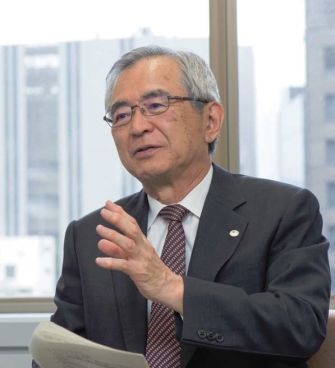
In Japan, the US and parts of Europe, GDP per capita is about US$40,000 to US$50,000, varying slightly due to currency exchange rates. At the same time GDP per capita for countries deemed middle-income in Asia differs sharply from as low as US$1,000 to around US$10,000. According to IMF data, GDP per capita in 2013 reached US$6,700 for the PRC, US$1,500 for India, US$3,500 for Indonesia, US$2,800 for the Philippines, and US$5,600 for Thailand. These are all deemed to be middle income countries, with the PRC a high middleincomecountry and India a low middle-income country.
In the case of the PRC, the challenges include appropriately managing environmental problems, tackling the decreasing birthrate and aging population, addressing social security gaps and urbanization pressures, and improving the efficiency of infrastructure and education levels. Such countries must continuously grow, but at the same time ensure that the results of this growth are felt by all members in society. Otherwise, political instability could arise. For lower middle-income countries including India, there are still many basic challenges. In particular, infrastructure is critical, with a strong need to further develop power networks and roads. They also need to focus on improving the quality of education in elementary and junior high schools, enhancing vocational training, and further developing their trade and investment environments.
Kawamura: So the challenges differ depending on the level of the middle-income country?
Nakao: Exactly. It depends on the development phase and situation of each respective country.
Kawamura: What we are most interested in is whether or not the PRC is actually going to fully unlock the power of its people and increase its GDP per capita by double or triple. I think it will take time, and I also feel it will be difficult.
Nakao: The achievements of the PRC have been remarkable since its opening to the world, and it continues to see high growth. In Japan’s case, after the bursting of the bubble economy at the beginning of the 1990s, the growth rate has languished around 1% or so at the very most, and the country has experienced deflation. Nominal GDP on a yen basis has barely increased, and even on a dollar basis, nominal GDP has not increased that much.On the other hand, even though the real growth rate of the PRC has decreased recently, it is still around the 7.5% level, and the nominal growth rate is at least 10%. Since the Chinese yuan is appreciating against the dollar, GDP in dollar terms has been increasing at tremendous speed. A decade ago, the PRC’s GDP was about half that of Japan. Now its GDP is almost double that of Japan.
At the same time the PRC is confronting a number of challenges,including widespread shadow banking* and local government financial difficulties. If these issues can be successfully tackled, pressure on the entire economy will decrease. At the Third Plenum of the Central Committee of the Communist Party held last fall, reform plans were revealed. The thrust is to put the market at the center of the economy rather than the government. The reforms also target enhanced social security, a decrease in disparities between rural and urban areas, respect for land use rights, overhauls of stateowned companies, and more liberalization of the financial sector.
These plans are very legitimate, and if they can be implemented in stages, I believe the problems the PRC is now facing will be overcome without any large negative impacts. In the longer term, though, whether or not the PRC can attain the same levels of GDP per capita as Japan and the US is still open for discussion. In the coming years, the problem of anaging society will come to the fore, and environmental and social problems will also be difficult to solve. To help catch up with Japan and the US, the PRC will draw on the models and technologies of advanced countries, but at a certain point they will also need to develop their own development models and technologies.
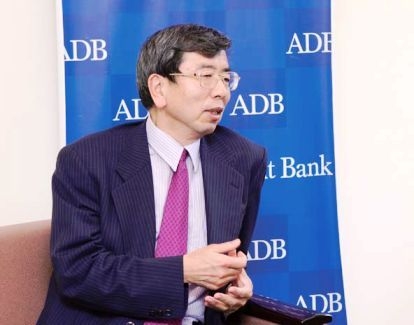
Kawamura: The development of technologies on your own is very hard, as is the phase countries face after they have imported technologies from advanced economies. Japan has found this out. So it will be hard for the PRC too. At Hitachi, visitors from the PRC frequently ask about how we go about conducting research and development, what we are working on, and whether or not we have seen returns from our research efforts. In the past we have also been asked about how we recovered our investments for developing bullet trains with funds borrowed from the World Bank.
Nakao: I remember that Namihei Odaira, the engineer who founded Hitachi around 1910, started the company from part of a mining business established by Fusanosuke Kuhara. Japan has a long history of capitalism as we can see with Hitachi, while the PRC has experienced a long period of socialism. In addition, even before that, the PRC leaned towards commercial capitalism, rather than placing importance on industrial capitalism.
I think Japan gets its strength from having placed importance on industrial capital since the late 19th century, as well as from the Japanese samurai warrior code, which values rectitude, the customeroriented spirit of merchants, and craftsmanship obsessed with perfection, which has been passed down since the 17th century. On the other hand, the PRC is focusing on the field of research and development, symbolized by venture businesses linked to Tsinghua University, and I feel various technological developments in the country are progressing at a faster speed than expected.
Kawamura: It depends on the field. In some areas, PRC technological developments have been progressing well.
Nakao: I believe that solar power generation is one such field.
Kawamura: I think the direction the country is heading will be affected by whether or not the PRC can enhance its technological developments further in future.
Kawamura: In Hitachi, we have been working on fostering the ability of employees and human resource development under various themes. At the ADB, there are staff from various backgrounds working there. How do you handle human resource development of such a diverse staff base?
Nakao: The ADB has about 3,000 staff members, with 1,050 designated as specialist personnel. Around 15% of the specialist personnel are Japanese. Other nationalities are varied and include citizens from the US, PRC, India, and Italy, among many others. Despite this diversity I believe all have a strong sense of loyalty to the ADB. There are no feelings of “I don’t like the President because he is Japanese.” In this sense, I believe the ADB is a very united organization. In terms of hiring, most staff taken on are recruited at the mid stage of their careers and the recruiting process is rigorous and professional. All recruitment and promotions are merit-based. Those who move to Manila to join the ADB headquarters are highly motivated to contribute to development in our region and have a strong desire to work for an international institution.
I think it’s important to nurture their motivations and desires carefully.In any organization, the number of posts increase as the organization grows before flattening out as the business stabilizes. In such situations, management of existing skilled talent, and promoting competent and highly-motivated staff members are most important. We proactively hire and promote female staff members, which I think is happening in every company nowadays. Approximately one third of our specialist personnel are female and depending on the year, half of all new hires are female. For our Japanese female staff, 43 are specialists and have work experience in Japanese and foreign banks, engineering companies, the Japan International Cooperation Agency, the Japan Bank for International Cooperation, and UN-related organizations, etc. Without a certain level of staff diversity the dynamism of the organization will be affected in the long term.
Kawamura: In Japan, there are many difficulties with handling staff since awareness of the seniority system is still so strong. However Japanese companies are in the process of shifting to merit-based evaluation systems as you mentioned. Many companies are consciously trying to carry out this shift.
Nakao: Getting promoted based on the seniority system strengthens unity and leads to an awareness of contributions to the company. Since the seniority system is easy to carry out I believe it was a reasonable approach for Japan during the high-growth period in particular. However, when the margin of growth of companies and organizations is smaller, if staff members are treated the same way regardless of their work achievements, a sense of unfairness emerges and, as a result, revitalization and growth of the organization is blocked.
Kawamura: Now, let us talk in a slightly broader perspective and let me ask you about the role of Japan. Can you tell us your thoughts on the role of Japan, or Japanese companies, in infrastructure projects in Asia?
Nakao: Japanese companies create extremely good products, such as bullet trains. Since Japanese companies have innovative technologies, they can be useful in supporting infrastructure development in Asia across many areas. However, in the current situation their prices are so high they rarely win projects when competitive bidding is held. Therefore, Japanese companies need to be more competitive in terms of pricing, while still maintaining their high technological standards. In fields where the ADB provides loans, many projects are relatively orthodox, and highly advanced technology which may only be available in Japan is not always required.
Kawamura: In negotiations for an electric power facility, we include the concept that our price is for the lifetime of the facility and promote the point that it will still be able to generate power properly even 10 years later. However, of course, the initial cost is high, so in many projects, it’s not easy to gain orders. Partly due to such circumstances, a trend of separating the part where development and production are conducted in Japan, and the part where development andproduction are not conducted in Japan, is spreading greatly.
Nakao: As is often discussed, it’s true that manufacturing everything only in Japan is becoming difficult. There is an argument that globalization leads to a hollowing out of domestic industry but I believe that Japanese companies cannot survive anyway unless they proactively and globally develop production. Even if Japanese companies deploy production globally, I think that in some areas such as technological development, capital goods, advanced parts, and some materials will remain in Japan.
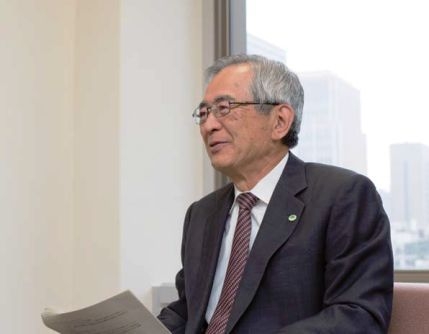
Kawamura: That is a very difficult matter. You are saying the concept of GNI* is important, right?
Nakao: I mean there is a shift taking place where we see more importance given to invisible earnings than on income from products, and on a country’s income balance rather than its trade balance.
Kawamura: I also think the concept of income will be important in the end.
Nakao: Income such as interest and dividends from investments in foreign countries, as well as patent fees and brand fees are becoming increasingly important for the Japanese economy. In addition, as well as selling a large volume of good products at inexpensive prices, Japanese companies need to move up the price value chain given the high acclaim for the country’s products. This is particularly\ the case when it comes to consumer goods including automobiles, electrical appliances, clothes, and commodities. Japan needs to capitalize on the widely held view that while its prices are slightly expensive the products are good. European brand companies are attracting those with money in Asia by using this measure. When we look at consumption in Asia, the middle-class is expanding greatly, and at the same time, I think the influence of the wealthy is large. In fact, the wealthy in the PRC and Southeast Asia have a very strong willingness to buy brand products. Japanese products have a brand element but I get the impression that the prices of those products are kept down compared to their quality. Including tourism and luxury goods, Japanese businesses need to make more money from the wealthy class in Asia, as well as developing a brand strategy for the rising middle-class. Of course there is still a demographic which will continue to want low cost products of poor quality. How to prioritize business while taking into account these three customer demographics is the challenge. Yet is easy to say these things since I’m not a market specialist.
Kawamura: You are scheduled to give a lecture at the 20th International Conference on The Future of Asia tomorrow (May 22, 2014). Can you reveal any of the contents of your lecture without giving away too much?
Nakao: In the Asian economy right now, demand is increasing due to the rise of the middle-class, and consumer confidence is extremely strong. Asia plays an important role not only as a production base but also as a consumer center. I believe that such consumption and domestic investment are supporting growth in Asia and making the economy strong. Some may argue that if the Federal Reserve Board reduces quantitative easing, funds will flow out of emerging countries and confusion will follow.
However, since the wider regional economy including the PRC and ASEAN countries is maintaining strength, I don’t think it will immediately hit a big wall even if there is a certain amount of market fluctuation.
However, as I mentioned earlier, many challenges lie ahead for Asia. In addition to the “middle-income trap”, tackling poverty in remaining low-income countries and dealing with contentious political issues, including geopolitical problems, are important. Asia’s economic growth and political stability have been built up over many years and I hope each country continues to pursue policies which will value such growth and stability in the future.
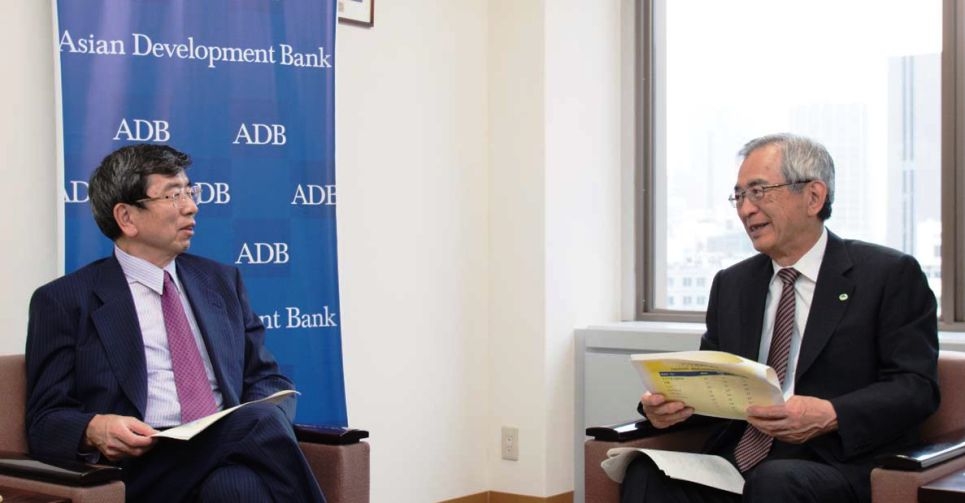
Kawamura: I think they should do so also for the purpose of preventing a recurrence of the Asian financial crisis in 1997.
Nakao: Exactly. Compared to that time, countries’ macroeconomic policies are now healthy, the financial sector is enhanced and the functions of central banks and financial regulations have improved. In addition, foreign currency reserves are large and borrowings of foreign currencies have been suppressed. Therefore, I don’t think something like an Asian financial crisis will occur again suddenly. However, the continuous pursuit of appropriate policies is still important.
Kawamura: While you were engaged in practical work as an administrative official, you managed to give lectures at Yokohama National University (lectures on finance in English for students from overseas in the first term of the 2002 school year) and the University of Tokyo (lectures on international finance in the first terms of the 2011 and 2012 school years). Can you tell us the reasons for engaging in practical work and research at universities at the same time?
Nakao: I did not do enough to say I was engaged in both work and research at the same time. But as I mentioned at the beginning of the interview, there are many mutually useful connections between academic theories and practical work. I believe that applying academic theory to practical work should be enhanced further in Japanese society. In the case of the US, we often see that academic fields such as economics, law, and accounting have been able to provide expertise in relation to practical work. The examples are economists, legal specialists, and accounting specialists. On the other hand, in Japan, the view is that daily practical work is more important than academia. One of the reasons why I teach is that I was asked to do so by an acquaintance from university. In addition, I thought sharing the knowledge I have gained from practical work with students, and recording what I have learned on paper, might be useful to society.
I also wanted to sort out my own thoughts and to use the opportunity of teaching to be inspired to study once again and to write papers. Teaching as a guest professor was hard because I had to use my weekends, yet I am really glad that I did. One achievement is that scholars and specialists now talk to me not only as an administrative official but also as a person who understands a little of the academic side of things. Furthermore, by writing papers and teaching at universities, I was able to train myself to speak in universal terms which can be understood by anyone from any country. When speaking at international conferences as Vice Minister in the past, and now when making speeches as President of the ADB, this experience has been very useful.
Kawamura: I think that is very meaningful. It’s very important to study again after entering the working world.
Nakao: When I was a university student I enjoyed my free time by watching movies, reading novels, and climbing mountains, and I often skipped class, so it’s strange, even for me, that I’ve become more scholarly recently.
Kawamura: Now, in relation to what we just discussed, I heard that you place importance on work-life balance. Can you tell us your thoughts on work-life balance and private hobbies?
Nakao: The Ministry of Finance of Japan now encourages its staff members not to stay too late. In the past, many directors stayed late at their offices and it was hard for their staff to leave. Therefore, when I became a director, partly because my wife was also working, I went home by 8 p.m., and I prepared dinner almost every day. My wife did the laundry and cleaning. In Manila as well, I try to cook as much as possible on Saturdays and Sundays without leaving it to the maid. My children seem to look forward to my cooking.
One of the reasons why I think work-life balance is very important is the sharing of housework is essential when women work. Another reason is I think, if you do not live an
ordinary life that includes housework, your thinking will not be in tune with how wider society thinks. If you work until late at night every day, you cannot think properly, and, first of all, if you don’t have personal time for your hobbies and to relax, you won’t know what your life is for. My hobbies are listening to jazz and classical music, taking walks, and enjoying and cooking delicious food. Since coming to Manila, I have started to play golf and tennis again after a 20-year break.
Kawamura: I would like more companies to head in that direction. I believe the situation where Japanese men compete against each other to see how late at night they can work is really not good.
Nakao: A situation where doing overtime is normal is a hard environment for women to work in, and I don’t think this situation contributes to productivity either. Japanese people’s attitude of pursuing perfection in work deserves praise but in other advanced countries, business works even though people do not do as much overtime and staff members are able to take proper vacations. Therefore, it should be possible for Japan as well.
Kawamura: What is your personal motto?
Nakao: I like the phrase, “Isn't it a pleasure to study and practice what you have learned?” from the “Analects” of Confucius, even though this is not my personal motto. As this phrase states, remembering what you learned once in a while and thinking about various things is fun, although it doesn’t happen very often in reality. Like the discussion about work-life balance, if you are not enjoying life you don’t know what you are living for and you cannot achieve anything, both for yourself and the organization. Since becoming President of the ADB, I often ask executive staff members who were recruited mid-career if they enjoy their work. If they do, it means they have a good relationship with their staff members and find their work worthwhile, and in most cases, their performance improves.
Another phrase I like that is also from the “Analects” of Confucius is, “Learning without thought is labor lost; thought without learning is perilous.” Thinking on your own while studying is essential. For example, when you are learning, thinking “this sounds slightly incorrect” or “this could be better if I do this” is important. Yet if you think on your own and if you do not learn from other people, you cannot come up with good ideas, of course, and it is also dangerous. By the way, I often naturally mention phrases from Chinese poems and the “Analects” when I meet Chinese people. In fact, I think there is no other country which studies and values Chinese culture as much as Japan does. My Chinese colleagues and friends are highly-educated, so they know about the achievements of Japan after the 19th century and its contribution to the development of Asia following World War II very well. Many Chinese people seem to know that the idioms of Chinese characteristics meaning freedom, society, capitalism, and executives were created by Japanese people. Therefore, when I in turn mention Chinese classics, the Chinese people seem to feel closer to me.
Kawamura: Chinese classics such as the “Analects” of Confucius have depth in many aspects.
Nakao: What kinds of phrases do you like?
Kawamura: I like the word “compassion”, for example.
Nakao: The same Chinese character is used for the expression meaning “forgiveness”.
Kawamura: When a pupil asked Confucius about what we should value for our entire lives, he answered it was compassion. In other words, compassion is probably the most important trait. Confucius is saying that whether or not you can properly think from the other person’s perspective is important.
Nakao: It truly has deep meaning. I think I also heard something like manners come from compassion. I can understand that. When I treat a junior staff member to dinner, I feel happy if they say, “Thank you for dinner yesterday” the next morning. When I was younger and when a senior staff member bought me dinner, I thought that just saying thank you at that time was enough. However, I now think that saying thank you the next morning once again is not only polite but at the same time also comes from compassion.
Kawamura: In conclusion, can you tell us about the dreams you would like to realize in the future?
Nakao: I think my dream is for Asia to continue to maintain stability including peace, economic growth, and prosperity, and to gain a greater voice in the world. I don’t think there are any particular Asian standards but I think the idea that western society created all good things in the world including democracy and markets, or human rights matters is incorrect. Western society made a great contribution by organizing these things, yet these are universal values in human society. For human rights as well, even during the Edo period in Japan starting from the 17th century, if a samurai hurt another person, the samurai was tried in court. In addition, there were facilities for orphans. Such ideas of human rights and protection of the vulnerable exist in every country. I hope that Asia can enhance its presence, influence, morals, and new ideas in the future.
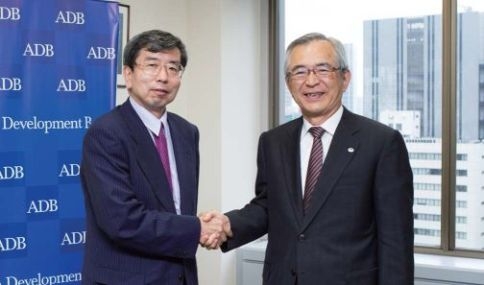
Kawamura: Asia has a large population, and I would like the region to continue to grow. Asia seems to have the ability to continue being stable and prosperous therefore, it would be great if many countries and regions, including Japan, successfully supported its growth. That’s what you are thinking, right?
Nakao: Asia’s situation also includes various issues and difficult historical problems. However, Asia has the potential for enhancing cultural and economic links in areas such as trade and investment. Therefore, I’d like these aspects to be focused on as much as possible to enhance the plus-sum.
Kawamura: Thank you very much for your time today.
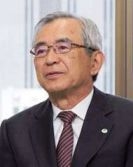
Mr. Nakao held var ious positions such as Budget Examiner, Director-General of the International Bureau, International Bureau, and Vice Minister of Finance after joining the Ministry of Finance of Japan. Currently, he has been working on economic development and reduction of poverty in Asia as President of the Asian Development Bank. In this interview, Mr. Nakao explained the changing roles of the Asian Development Bank, problems of the “Middleincome Trap”, and roles of Japanese companies in Asian infrastructure projects, etc. Mr. Nakao maintains a good balance of work and life, and his motto, “There is no good work without enjoying both work and life” made me realize once again the importance of promoting both the involvement of women in the workplace and the pursuit of work-life balance. In addition, Mr. Nakao’s practice of engaging in both practical work and research as they relate to his pursuit of aspirations and self-realization inspired me greatly.